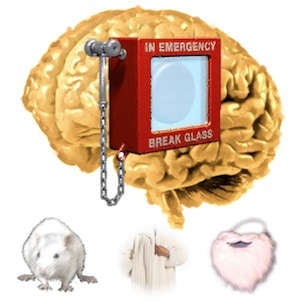 Qu. What do a rat, a fur coat, and a Santa mask have in common?
Qu. What do a rat, a fur coat, and a Santa mask have in common?
Ans. Ethically dodgy science!
‘Little Albert’ was the victim of early 20th century psychology experimentation. At nine months of age he was given a white rat, and then frightened by a loud noise whenever he reached for it. Naturally, he came to fear white rats. Surprisingly, he also came to fear things that shared characteristics with the rat such as other animals, a fur coat and a person with Santa Claus beard. This spread of fear is common among individuals with anxiety disorders – phobias, post-traumatic stress and the like.
One explanation of this is that there is a problem in the brain’s ability to tell the difference between cues truly associated with danger (the rat), and cues simply sharing some of the characteristics of that cue (Santa beard and coat). The result is the inappropriate breaking of the proverbial ‘in case of emergency’ glass, activating physiological alarm systems – inappropriately.
So, how does the brain tell such cues apart? The authors of a recent article (published in Nature Neuroscience[1]) think that it relates to whether your brain’s secretary has a meticulous, well-labelled filing system with many subfolders. This kind of filing system is established by a process called ‘pattern separation’ – the process by which (even) similar cues (and their meaning) are transformed into discrete, non-overlapping neural representations or memory files. If the representations of cues that share characteristics are not filed in discrete folders, then activation of one folder (i.e. the fur coat) may also inappropriately activate another (i.e. the rat).
The authors go on to suggest that brain areas (the hippocampus) and neurophysiological processes (neurogenesis) have been shown to be fundamental in the process of pattern separation[1]. They suggest that stimulating neurogenesis in the hippocampus might enhance pattern separation and ameliorate anxiety (or, at least, relevant phenotypes of the disorder)1.
Seems like a hypothesis worth paying attention to!
Could this theory relate to chronic pain?
Here I see two potential links to chronic pain. The most obvious link relates to subgroups of patients in whom pain-related fear and anxiety are prevalent and are primary drivers of distress and disability[2,3]. Here, impaired pattern separation may help to explain the spread of fear from true danger cues to activities and movements which are not truly dangerous.
Secondly, failure of pattern separation may provide a mechanism by which non-nociceptive cues might come to activate pain responses. That is, if representations of non-noxious cues are filed in a way that overlaps with representations of painful noxious events, these non-noxious cues might come to cause pain. One example of this might be dysynchiria[4], shown to occur in some patients with Complex Regional Pain Syndrome. Dysynchiria is a phenomenon where visual input (looking at the reflection of the non-affected hand placed to look like the affected hand) elicits a painful response. Perhaps an overlapping visual and noxious (hand-related) filing has enabled visual input to activate pain representations. Certainly an idea worth pursuing….
In the meantime, I hope my external filing system is not a reflection of my internal one!!
Daniel Harvie
 Daniel is a recently commenced PhD candidate in the Body in Mind Research Group at UniSA. He has a clinical physiotherapy background and is a graduate of the Master of Musculoskeletal and Sports degree at the University of South Australia. His research will look at the application of learning models to the development and extinction of chronic pain.
Daniel is a recently commenced PhD candidate in the Body in Mind Research Group at UniSA. He has a clinical physiotherapy background and is a graduate of the Master of Musculoskeletal and Sports degree at the University of South Australia. His research will look at the application of learning models to the development and extinction of chronic pain.
He enjoys writing and recording music, hasn’t had a car for months (an experiment) and has a bionic knee.
References
1. Kheirbek MA, Klemenhagen KC, Sahay A, & Hen R (2012). Neurogenesis and generalization: a new approach to stratify and treat anxiety disorders. Nature neuroscience, 15 (12), 1613-20 PMID: 23187693
2. Vlaeyen JW, & Linton SJ (2000). Fear-avoidance and its consequences in chronic musculoskeletal pain: a state of the art. Pain, 85 (3), 317-32 PMID: 10781906
3. Crombez G, Eccleston C, Van Damme S, Vlaeyen JW, & Karoly P (2012). Fear-avoidance model of chronic pain: the next generation. The Clinical journal of pain, 28 (6), 475-83 PMID: 22673479
4. Acerra NE, & Moseley GL (2005). Dysynchiria: watching the mirror image of the unaffected limb elicits pain on the affected side. Neurology, 65 (5), 751-3 PMID: 16157911



